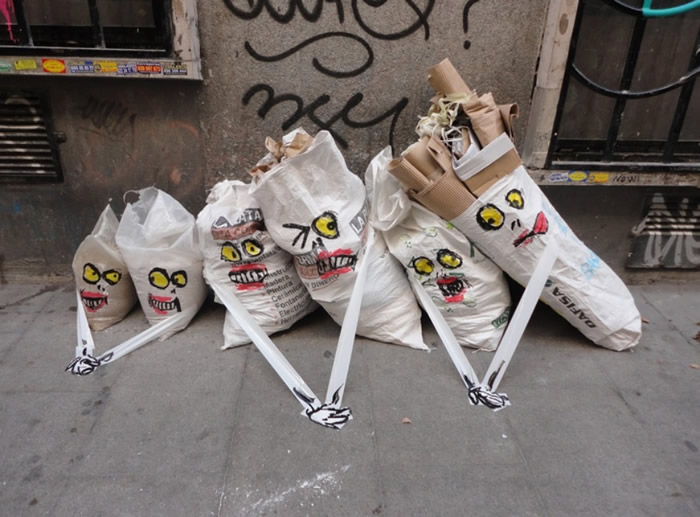Art is Trash

Trash is not a pleasant sight. Nobody likes to be around it. But it’s also a fact that you can’t escape it either. They can be seen all around humans reside. There is a genius here who found an innovative way to lend a pretty hand to trash. This Spanish artist Francisco de Pajaro wields his magical wand and changes your opinion and perception about trash.
Frightened yellow eyes stare out, figures clutch each other with arms made from packaging tape, Native Americans ride mattress horses. This is Art is Trash, sculptures of ephemera that have been popping up on London’s street corners, created out of rubbish discarded every day.

Barcelona-born street artist Francisco de Pajaro rejoices in the here-today-gone-tomorrow nature of his work, turning bin-bags, boxes, broken furniture and other detritus into human figures, monsters and animals. Sometimes they are rude and licentious, sometimes political or funny, often scared with wide eyes – one garbage sculpture was of a petrified Julian Assange clutching an equally terrified Edward Snowden. All of de Pajaro’s pieces can easily be seen as artistic suicide, creative works destined to be destroyed in a bin lorry unless salvaged before the streets are cleared.
De Pajaro has to work quickly: he sees a pile of rubbish, moves it around, paints it, sticks it with tape, leaves his trademark moniker and walks away – with a smile. “I am creating fun and beauty out of something society considers gross and disgusting,” he says. “Garbage is hated, ignored, considered smelly and rotten. But for me it has become a place to create monsters, to make fun of politicians and the humourless.”

De Pajaro moved to London to escape the economic crisis in Spain and restrictive laws outlawing street expression. “Painting trash in London is certainly not making me any money but it is great fun,” he laughs. “I don’t feel exploited by anyone in this, I can say what I want to and many many more people are getting to see my work than if I was in a gallery. I thought it was absurd to paint pictures that no one would buy. I began to see that the art market was flocked with vultures and my notion that if I didn’t hang in a good gallery, I was a nobody. I turned my thinking on its head and took to the streets.”
Much of the London work has been captured on social media, particularly on Instagram under the hashtag #artistrash. De Pajaro says: “I don’t have my own Instagram but it is great that people are enjoying it there because my work is so ephemeral. It’s nice to see this giving it some sort of permanency. The overall reaction has been positive – but I also quite like painting for people who hate it, for people who are snobs and think they are better than others. If you look closely, some of them are my monsters.”
First published by Audrey Gillan at The Guardian

